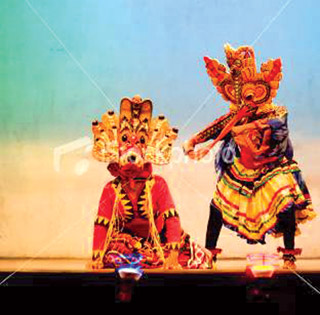Kandyan dance Vannam
Influence of Hinduism and Tamil Tradition:
Subashini PATHMANATHAN
It's a reality that the Tamils and Sinhalese live together in this
Island for centuries. Both these communities are linked together by
religion, language, and culture. They are inter-related with one another
with peace and harmony. Each community respects each others culture,
traditions, religion, and the arts.
We know that many Buddhists visit Hindu Temples and worship the Hindu
deities. They worship with total devotion, make vows for their different
needs, and promptly fulfill their vows with devotion and dedication.
Similarly many Hindus also visit the Buddhist temples and worship Lord
Buddha and other Hindu deities which are installed there for worship.
Such attitudes bring communal harmony, religious harmony, and mutual
understanding between the two main ethnic communities. Longstanding
relationship between the two communities naturally influences one
another's cultural relationship.

May I digress for a moment.
My father was an ardent devotee of the Buddha. After his demise,
according to his wishes, my family installed a Buddha statue at one of
the Buddhist temples in Kesbawa, for public worship.
Vannam is one of the Kandyan dance forms. There are altogether
eighteen Vannams in the Kandyan dance. Each Vannama is based on separate
theme. The last inclusion of Vannam in Kandyan dance has provided a lot
of scope for Nirthya movements in the Kandyan dance.
Generally the Vannam is based on numerous themes. It is based on
various themes, such as folk legends, nature, and religion. Most of the
Vannam describe the behaviour of animals such as elephants, monkeys,
rabbits, cobra, and birds. Each Vannama is based on separate imaginative
theme.
First among the Vannam is Gajaga Vannama. In Tamil language, Gaja
means elephant. Lord Ganesha the elephant faced God is always called as
Lord Ganapathy, Gajan, Gajamugan, Gajavathan, Gajendran, Gaja Nathan,
and Gaja Mohan. Gajaga Vannama is based on a particular legend. It deals
and explains that Iravana, an elephant, sporting in the cool water of a
lotus tank. The movements of the elephant's majestic movements, majestic
twists, majestic steps, are naturally and beautifully reflected in the
Vannama. This is a most attractive Vannama.
There is another Vannama on God Ganesha. In this Vannama, the dancers
invoke the blessings of Lord Ganesha. This Vannama is Called Ganapathy
Vannama.
Another Vannama is Naiyandi Vannama. In Tamil there was a Melam
(orchestra) called Naiyandi Melam which was quite popular and was in use
long ago, but still in some places Naiyandi Melam is practised.
The Naiyandi Vannama is dealing with a story connected to a princely
Naga (cobra); the snake charmer's movements are reflected less in this
dance, but the movements of the snake are reflected more in the dance.
For this Vannama, Sarpa Sirasa hand gesture is used. The Sarpa Sirasa
hand gesture is used in Bharatha Natyam and Kathakali.In Bharatha Natyam
the Naga Narthanam is specially a dance, which depicts the dance of the
Cobra. Another Vannama called Naga Vannama depicts, the one day life of
a Cobra which crawls on the floor of the court halls, and depicts how
the Cobra emerges out of its hole, and how the cobra raises its hood in
different, directions. This depicts the real natural movements of the
Cobra.
In Bharatha Natyam the single hand Muthra Sarpasirasa and the joint
hand Mutha Naga Bandha, Muthras (gestures) depict the Naga (cobra)
Muthras.
Another Vannama is called Hanuma Vannama. In Hinduism, Lord Hanuman
worship is worldwide, for bravery, moral strength, and protection. In
this Vannama the dancer reveals the actions, and different attitudes of
a monkey, through the movements, by jumping, from tree to tree etc. The
dancers dress themselves as monkeys, with wrinkled faces, and jutting
eyes.
Some of the Vannams are directly linked with Hindu mythology, for
instance, SavulaVannama is almost based on Skanda Purana.According to
this Vannama, there was turmoil between the Asuras and the Devas.
At the end Lord Skanda entered the battle field with sword, and
spear, and fought with the Asuras.At last one of the Asuras was split,
into two by the Lord Skanda. In Hinduism Lord Skanda killed the Sooran
(Asura) who was split by Lord Skanda into two, who there- after became a
cock, and a peacock.
Mayura Vannama is another Vannama.The theme of the Vannama is about
the peacockVahana, of Lord Kataragama, Singhala Buddhists worship the
Lord Kataragama. Lord Skanda or Lord Muruga, whose vahana is peacock,
which is also called in Tamil as Mayuram. Lord Skanda or Lord Murugan is
often called Mayuran. The Mayura hand Mutha is used in Bharatha Natyam
and Kathakali to depict the peacock.
Another Vannama deals with the Victorious dance of Lord Iswara (Lord
Shiva), after finding the Goddess Uma.It is based on a theme.
The Lord Iswara disguises himself and went in search of his consort
the goddess Uma, and as he was overjoyed, after finding her, he danced
vigorously with firm and majestic Thandava movements.
Musaladi Vannama is another Vannama.This dance has the influence of
the Tamil word Musal.In Tamil Musal means Rabbit. In this Vannama the
dancer, imitates the movements of a Rabbit.
Imaginative movements of Rabbits are well depicted in this dance,
hiding with fear, jumping, running, in a zig zag manner, and hopping. At
the end the Rabbit takes rest under the cool moon light.
Another Vannama deals with Lord Brahma, Lord Visvakarma, and Lord
Iswara, (Lord Shiva). Lord Shiva blew the conch before the King of the
universe. This particular Vannama also directly one-way or other
connected to Hinduism.
There is another Vannama which is called Vairodi Vannama, which deals
about the precious brilliant (diamond) stone. Even in Tamil precious
brilliant (diamond) stone is called Vairam.
Hence most of the Vannams are based on Hindu religious and Hindu
themes. The above said descriptions reveal that for centuries, and
centuries both the major communities in the country lived together with
one and other in peace and harmony. Both the communities respect and
follow one another's traditional practices. |



